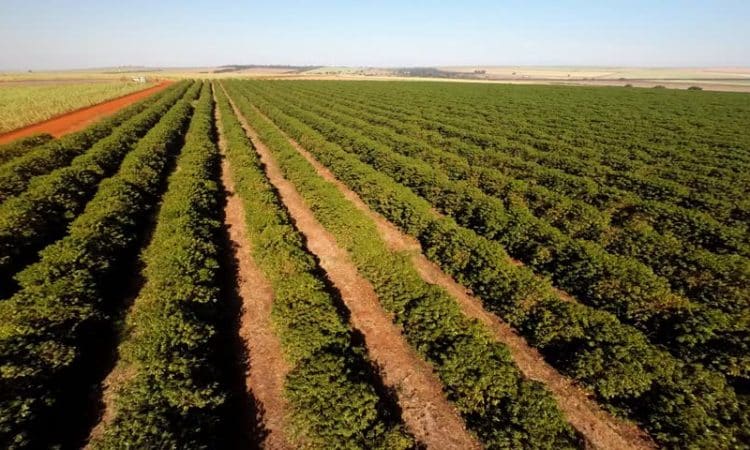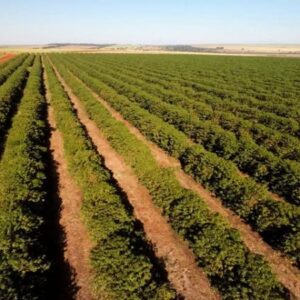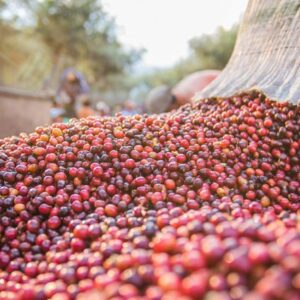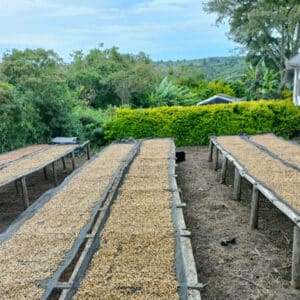Uganda – Bukonzo Joint Cooperative FTO
Caramel | Chocolate | Fruity
About This Coffee
The Bukonzo Joint Cooperative Union (BJCU), founded in 1999 in Uganda’s Rwenzori Mountains, has grown into a leading producer of high-quality organic and Fairtrade-certified Arabica coffee. Originally a rural micro-finance society, BJCU now supports over 1,700 smallholder farmers and operates 15 farmer-owned washing stations. By shifting from natural to fully washed processing, the cooperative has significantly improved coffee quality and market value. BJCU is also known for its commitment to gender equity, implementing the Gender Action Learning System (GALS) to ensure women’s active participation in decision-making. Additionally, the cooperative reinvests Fairtrade premiums into community initiatives, such as maternal healthcare, while promoting sustainable farming practices like organic composting and intercropping with bananas, beans, and vanilla. Through these efforts, BJCU has strengthened both the livelihoods of its farmers and the reputation of Ugandan coffee on the global stage.
| Origin | Uganda |
|---|---|
| Region | Rwenzori |
| Altitude | 1,400m – 2,200m |
| Producer Type | Various Smallholder Farmers (5,500 farmers, 83% women) |
| Harvest Season | 2024/25 (Main: Sep–Jan, Fly Crop: Mar–May) |
| Processing | Washed |
| Varietals | SL14, SL28, Nyasaland |
| Plant Species | Arabica |
|---|---|
| Post-Harvest Handling | Hand-picked, carefully sorted, wet-processed, and sun-dried on raised beds |
| Bag Type | Grain Pro / Ecotact |
| Certifications | FLO Fairtrade Certified, Organic Certified |

Uganda’s Coffee Journey
Uganda’s coffee heritage is deeply woven into its landscape and culture. For centuries, wild robusta trees flourished in the country’s rainforests, where local communities chewed the beans for energy and used them in rituals. Coffee’s commercial journey began under British colonial rule, with Arabica introduced to the highlands and robusta cultivated on a larger scale. After independence in 1962, coffee quickly became Uganda’s most valuable export, though political and economic instability posed challenges. A resurgence in the 1990s, fueled by investment and modernization, helped Uganda establish itself as one of Africa’s top coffee producers. Today, the country is known for its rich, full-bodied robusta and high-altitude Arabica, both gaining recognition in the global specialty coffee market.
Cultivating Coffee in Uganda
Uganda’s diverse landscape offers excellent conditions for coffee farming, particularly for Arabica varieties, which flourish in the high-altitude regions of Mount Elgon in the east and the Rwenzori Mountains in the west. These elevations, stretching from around 1,300 to 2,300 meters above sea level, create an ideal climate with cool temperatures and nutrient-rich volcanic soils that enhance coffee quality. Ugandan farmers produce both washed and natural Arabica coffees, while innovative processing techniques such as honey processing are becoming increasingly popular. The country cultivates several Arabica strains, including SL14, SL28, and Blue Mountain, yielding specialty-grade beans like AA, AB, and Peaberry, prized for their vibrant flavor profiles and superior quality.

Sample Roasting: A Step-by-Step Guide
Consistency is essential in sample roasting, but the timing of the first crack can vary from batch to batch. To ensure optimal results, use this guide to determine the ideal moment to end your roast based on how long it took to reach the first crack.






